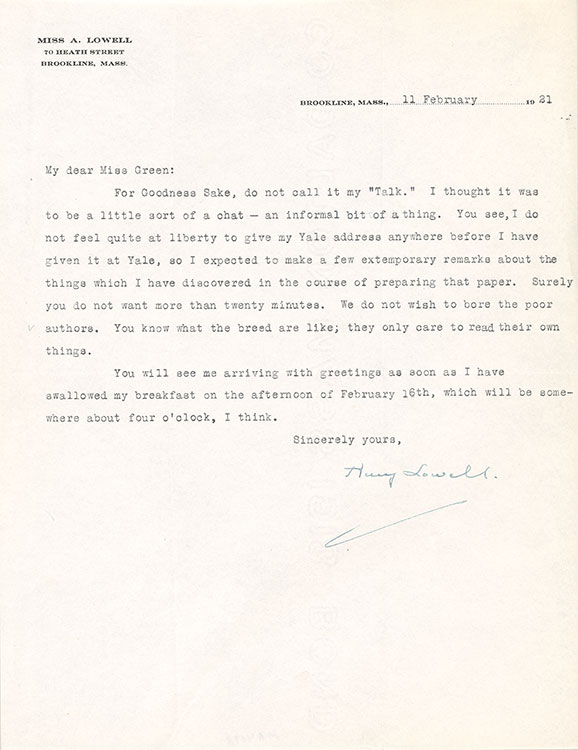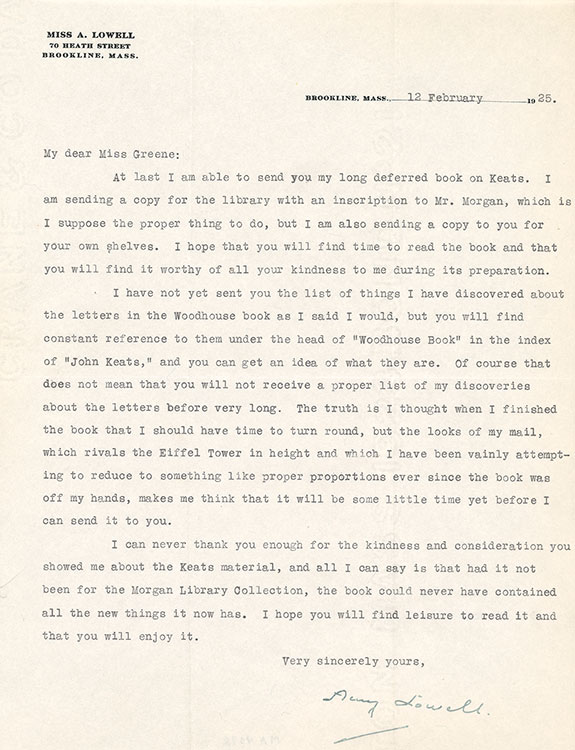Amy Lowell, Keats Collector

In February 1921, the Boston poet Amy Lowell (1874–1925)—Greene’s friend and the preeminent American collector of Keatsiana—was due to give a talk at Yale to mark the centenary of Keats’s death. In preparation for her talk, she contacted Belle Greene on February 3 to arrange a visit to the Library, where she wished to consult “not only the ‘Endymion’ etc., but the communication from Woodhouse to Taylor, and things of that sort.” At the time Lowell was working on a major new biography of John Keats, which for the first time drew prominently on manuscript material in American collections, primarily her own and Morgan’s. (Lowell would leave her collection to Harvard, which now holds the largest collection of Keats manuscripts in the world.) Though Sidney Colvin had briefly touched upon items at the Morgan for his 1917 Keats biography, Amy Lowell would be the first scholar to seriously study this material. Her knowledge of the collection’s depth—which, as she recognized, extended well beyond the famous Endymion manuscript—is emblematic of her meticulous research into archival sources about Keats.
Amy Lowell, typed letter to Belle da Costa Greene, 3 February 1921. MA 4098. Archives of the Morgan Library & Museum.
Amy Lowell letter to Belle da Costa Greene, 5 February 1921

Writing again on February 5th, Lowell began to make arrangements for a research trip while also accepting Greene’s invitation to address the Authors Club of New York at a private event in the Library. Greene was planning a display of Morgan materials to accompany Lowell’s “talk,” though, in another letter dated February 11th, Lowell playfully requests she refer to it using a different word: “For Goodness Sake, do not call it my ‘Talk.’ I thought it was to be a little sort of a chat —an informal bit of a thing.” These letters also allude to Lowell’s romantic partner, the actress Ada Dwyer Russell (1863–1952), whom she planned to bring along on her visit to the Library. Lowell’s two-volume John Keats would appear in 1925 with a dedication to Russell, the first and only publication Lowell dared dedicate to her life partner: “To A.D.R. This, and all my books A.L.”
Amy Lowell, typed letter to Belle da Costa Greene, 5 February 1921. MA 4098. Archives of the Morgan Library & Museum.
Amy Lowell letter to Belle da Costa Greene, 11 February 1921

Amy Lowell, typed letter to Belle da Costa Greene, 11 February 1921. MA 4098. Archives of the Morgan Library & Museum.
Amy Lowell letter to Belle da Costa Greene, 23 November 1921

Lowell was the first scholar to study the “Woodhouse Book,” the bound compilation of letters, documents, and transcribed poetry assembled by the collector, lawyer, and Keats contemporary Richard Woodhouse. Lowell’s book on Keats explores various objects within the volume, including the library catalogue drawn up by Charles Armitage Brown along with unpublished letters between Woodhouse and Keats’s publisher John Taylor. In an age when the photographic reproduction of special collections material was hardly widespread, Lowell’s research necessitated several trips to New York to consult the manuscript. At one point she even sent Greene a “'cheeky' request” to consult the volume overnight in her hotel room while recovering from surgery. Greene agreed to the unconventional arrangement, humoring a friend and trusted colleague whom she clearly admired: in a letter from June 1921, Greene wrote, “What we ‘think of you’ is entirely too complimentary for transmission by mere paper."
Amy Lowell, typed letter to Belle da Costa Greene, 23 November 1921. MA 4098. Archives of the Morgan Library & Museum.
Belle da Costa Greene letter to Amy Lowell, 29 June 1921

Belle da Costa Greene, retained copy of typed letter to Amy Lowell, 29 June 1921. MA 4098. Archives of the Morgan Library & Museum.
Amy Lowell letter to Belle da Costa Greene, 12 February 1925

In February 1925 Lowell completed her book and sent a copy to Greene, inscribing it “Belle da Costa Greene, with the grateful regards of Amy Lowell.” Lowell’s preface acknowledges the importance of private collections to her research, giving pride of place to the Morgan:
To Mr. J.P. Morgan of New York, owner of the Morgan Library, which he has just formally put at the service of students, but which has in fact always been at their service, assisted by the expert advice of its remarkable librarian, Miss Belle da Costa Greene, I am deeply obliged. Through Miss Greene’s kindness I have had free access to the Library for the past four years, and have been permitted to make such transcripts of manuscripts as I needed.
In a letter accompanying the gifted volumes (one for the Morgan’s reference collection, one for Greene), Lowell expands her thanks:
I can never thank you enough for the kindness and consideration you showed me about the Keats material, and all I can say is that had it not been for the Morgan Library Collection, the book could never have contained all the new things it now has. I hope you will find leisure to read it and that you will enjoy it.
Greene’s response is warm and grateful:
You have simply overwhelmed me in presenting me (personally) with a copy of your “John Keats”. I had stupidly thought to wait until I was able to read every word of it, before writing you—but I find myself continuously going back and re-reading portions of especial interest and importance to me—and so have not yet finished Volume One! And I feel that I cannot allow any further time to elapse before I thank you, truly from my heart, for both your wonderful mention of me in your preface and for the gift of this really great book.—which will always remain one of my most treasured possessions.
Amy Lowell would tragically die a few months later, in May 1925, but her John Keats has endured as one of the most important early twentieth-century biographies of the poet. The copy she gave Belle Greene sits on the shelves of the Morgan’s reference collection today.
Amy Lowell, typed letter to Belle da Costa Greene, 12 February 1925. MA 4098. Archives of the Morgan Library & Museum.